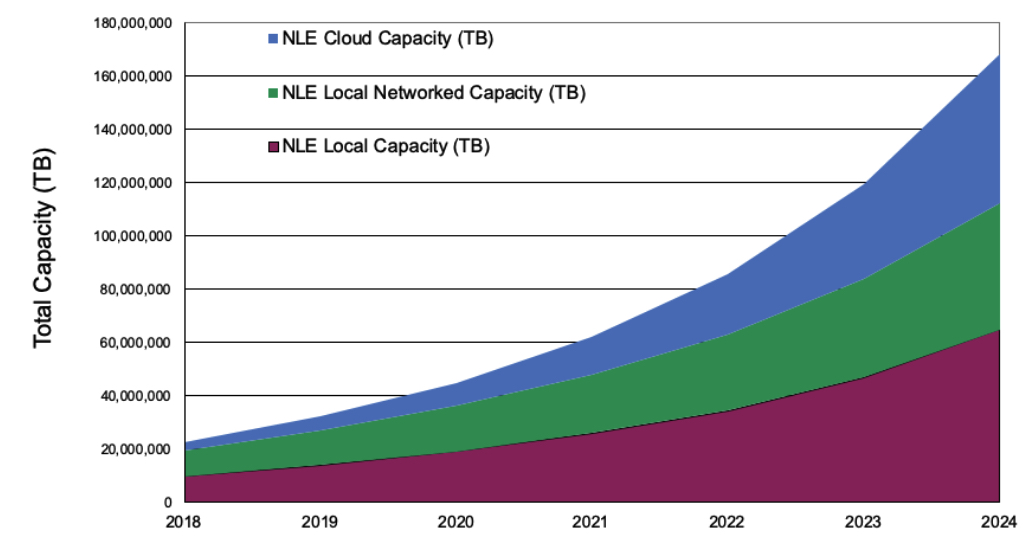NVMe Driving Changes in Traditional M&E Storage Hierarchy
White paper writtren by Tom Coughlin
This is a Press Release edited by StorageNewsletter.com on January 21, 2020 at 2:06 pm This is an abstract of a white paper written Tom Coughlin, president, Coughlin Associates, and sponsored by Quantum Corp.
This is an abstract of a white paper written Tom Coughlin, president, Coughlin Associates, and sponsored by Quantum Corp.
NVMe: Driving Changes in the Traditional M&E Storage Hierarchy
M&E trends
M&E storage and bandwidth requirements are increasing thanks to higher resolution content combined with higher frame rates, higher number of bits per pixel and more cameras per project.
This richer content must be created cost effectively and with the most efficient use of physical and human resources possible.
In many ways the anticipated future is arriving faster than originally projected in the media industry.
For example, NHK in Japan will be broadcasting the 2020 Olympics in 8K.
Taking note of this trend, camera manufacturers are committing to bringing ultra high-resolution to the masses, with 8K cameras already available from Red Digital, Sony, Canon and several others.
These cameras often capture content at multiple Gb/s data rates and store more than a terabyte of digital content per hour.
Besides impacting professional video camera storage and memory needs, these trends are also driving higher bandwidth and processing power for video rendering and special effects.
A 4K 360° video project may use 4 to 16 cameras, each capturing a separate stream of 4K or even 8K content. After they are captured, multi-camera streams for 360° video must be stitched together, resulting in a much larger composite video file.
Such an operation is heavily dependent on the underlying storage architecture, requiring considerable bandwidth and processing time. The major post production software companies are also getting in on the action, supporting 8K workflows across numerous content applications. Even the upcoming Xbox Project Scarlett and PS5 game consoles will have 8K graphics support by 2020. And finally, 8K TVs are available from all the major consumer electronics companies.
In addition to games, higher resolution content is available on streaming and other distribution channels, as most media organizations understand this content is favored by consumers (assuming the quality of content delivery is acceptable).
Taken together, this drastically impacts storage and bandwidth demands for content transcoding, IMF operations and content distribution. For those in the M&E industry tasked to work with and produce content at such high fidelity, it is increasingly apparent that new technologies must be leveraged to support these workflows.
One such example is increasing efficiency by handling this content with advanced asset management tools – many of which now deploy AI algorithms to help users find and access media content. Another example is using advanced lossless and lossy compression technologies to reduce the size of delivered content.
Finally, one of the most well-utilized and best ROI methods for dealing with these new requirements is to use the inherent capabilities of different types of modern storage media.
Digital storage options for media post-production
With the growth in both size and amount of digital content, total storage capacity for media post production is rapidly increasing.
The figure below shows projections for the growth of local direct attached, local network and cloud storage for post-production applications out to 2024.

HDDs are historically the most popular storage media in media post production facilities, sometimes with magnetic tape or storage in the cloud used to backup or archive media content. The cloud (tiered storage in data centers) is often used for storing and sharing content for collaborative media editing projects.
Although HDDs will remain an important storage media for parking content and storing content not frequently accessed, they have inherent performance limitations in the context of editing today’s high capacity and high bandwidth 4K+ content.
Thankfully, as manufacturing efficiencies have improved and competition has become more fierce, the economics of NAND flash memory has improved enough such that many organizations are now able to consider this storage media for a larger%age of post-production workflows.
Like most developments in the technology industry, things rarely stay stagnant for long, and such is the case with flash memory devices. Although SATA and SAS SSDs are widely used, these older interfaces (originally created to support the needs of HDDs) can restrict the data rate and latency that SSDs are capable of achieving. This has led to the wide use of an interface that brings more of the internal performance of the SSD to the computers it is connected to. This new interface is called NVMe.
NVMe SSDs
They avoid many of the built-in delays in SATA and SAS interfaces. A key reason for this is that they are based upon the PCIe bus used in modern computer systems, which allows the devices to support many more commands per queue than either SATA or SAS. The PCIe bus roughly doubles the available per lane data rate about every 3 years, providing greater bandwidth for video workloads.
PCIe 3.0 is being used widely today and provides 8 giga-transitions per second (GT/s) per lane while PCIe 4.0 is starting to appear in computer systems, providing 16 GT/s per lane. This roadmap for supporting technology means even higher data rates will be possible in the future.
NVMe SSDs come in several form factors and can use multiple PCIe lanes to provide higher performance. These form factors can look like 2.5-inch HDDs or be very compact to fit into a tablet-sized computer system. NVMe SSDs are used in mobile computers, tablets and enterprise storage systems. 2.5-inch form factor NVMe SSD is often used in enterprise storage systems.
From the perspective of performance, it’s no surprise that NVMe SSDs are increasingly used as primary storage for many M&E applications. They also provide lower latency to content than HDDs, which can facilitate the creative process for media professionals. However, performance is not the only reason organizations are making the switch to NVMe SSDs. With the lower price of SSD storage, their TCO has declined, making the lower capacity less of a trade-off than it was just a few years ago.
Organizations are also benefiting from lower data center costs thanks to the reduced power and cooling requirements of SSDs, as well as the greater performance density they can offer. In some use cases, organizations are leveraging the capability of these devices to provide high-performance across an all-IP network, enabling them to switch from FC to Ethernet-based infrastructure, further improving the overall economics of their storage environment.
Some M&E uses for NVMe SSDs
One compelling use case for NVMe is to support video projects that involve high frame rate, high bit per pixel 8K video.
Editing this content can require nearly 10GB/s streaming performance at sub-16ms latencies – performance which pushes traditional HDD storage to the limit. NVMe-based storage can provide low latencies and the bandwidth required to edit a raw 8K video project.
Another use case involves content created using multiple cameras capturing 4K+ video and then working with multiple streams of these high bandwidth assets. Because of its random IO/s performance, NVMe-based storage can provide the low latencies required to edit multiple Gbps data streams and to stitch together 360° multiple camera video.
Another applicable use case for NVMe is for visual effects and rendering tasks, especially given their intermittent data demand. All of the render engines in a render farm tend to get new data from storage at about the same time, making the peak bandwidth demand to efficiently service these render engines very high. NVMe-based storage can service the very high intermittent demand for 8K and higher rendered content more efficiently than an HDD-based storage system.
Best practice implementation of NVMe storage arrays
Because the raw storage capacity cost of HDDs is considerably less than SSDs, many people seek a less expensive storage option for their M&E workflows. However, there are good reasons to consider including NVMe SSD storage in your workflows, and one should consider more than the capital cost in deciding to use one type of storage over another.
Following are several aspects of NVMe to consider that tend to break with conventional wisdom.
Cost: First, the cost for a given amount of SSD storage capacity has dropped considerably over the last year or so, making the purchase of some flash memory much more affordable. And because SSDs are built using a bunch of NAND flash chips on a circuit board, they can be made very small and dense, allowing more storage in a given data center footprint than HDD storage.
In addition, NVMe SSDs can be built into storage systems using NVMe-oF where that fabric can be Ethernet. This enables NVMe storage systems to play an important role in IP-based workflows.
Lower latency: HDD systems, even when they can provide the required data rate, have considerably higher latency than SSD systems. This can make a big difference for the efficiency of your creative professionals, allowing them to not only get more work done in less time, but also give them more creative freedom to produce even better content. Such improved throughput and content of creative staff can more than compensate for the additional cost of SSD storage.
Multi-tier benefits: Finally, SSDs can be a part of a multi-tiered storage system, allowing an optimal combination of less expensive HDD storage and higher performance NVMe SSD storage. Less active data stays on the HDDs and only active data is on the SSDs.












 Subscribe to our free daily newsletter
Subscribe to our free daily newsletter
